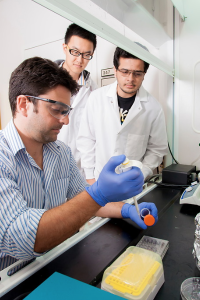Document Type
Article
Publication Title
Biomedical Materials
Abstract
A key step during the synthesis of collagen constructs is the incubation of monomeric collagen in phosphate buffer saline (PBS) to promote fibrillogenesis in the collagen network. Optimal PBS-treatment conditions for monomeric collagen solutions to induce gelation are well established in the literature. Recently, a report in the literature (Cheng et al 2008 Biomaterials 29 3278-88) showed a novel method to fabricate highly oriented electrochemically aligned collagen (ELAC) threads which have orders of magnitude greater packing density than collagen gels. The optimal PBS-treatment conditions for induction of D-banding pattern in such a dense and anisotropic collagen network are unknown. This study aimed to optimize PBS treatment of ELAC threads by investigating the effect of phosphate ion concentration (0.5x, 1x, 5x and 10x) and incubation time (3, 12 and 96 h) on the mechanical strength and ultrastructural organization by monotonic mechanical testing, small angle x-ray scattering and transmission electron microscopy (TEM). ELAC threads incubated in water (no PBS) served as the control. ELAC threads incubated in 1x PBS showed significantly higher extensibility compared to those in 0.5x or 10x PBS along with the presence of D-banded patterns with a periodicity of 63.83 nm. Incubation of ELAC threads in 1x PBS for 96 h resulted in significantly higher ultimate stress compared to 3 or 12 h. However, these threads lacked the D-banding pattern. TEM observations showed no significant differences in the microfibril diameter distribution of ELAC threads treated with or without PBS. This indicates that microfibrils lacked D-banding following electrochemical alignment and the subsequent PBS-treatment-induced D-banding by reorganization within microfibrils. It was concluded that incubation of aligned collagen in 1x PBS for 12 h results in mechanically competent, D-banded ELAC threads which can be used for the regeneration of load bearing tissues such as tendons and ligaments.
DOI
10.1088/1748-6041/6/3/035008
Publication Date
6-2011
Recommended Citation
Uquillas, J. A., Kishore, V., & Akkus, O. (2011). Effects of phosphate-buffered saline concentration and incubation time on the mechanical and structural properties of electrochemically aligned collagen threads. Biomedical Materials, 6(3).


